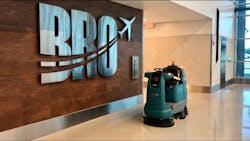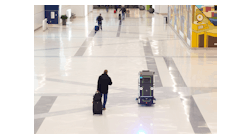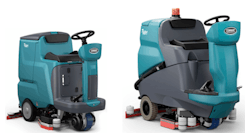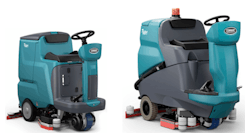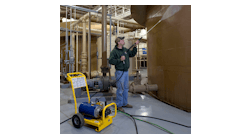The Rise of the Robots
There are robots in the terminal. But it’s not an Isaac Asimov novel – it’s the future of airport cleaning. Autonomous technology has taken on a new life in airport spaces, fueled in part by the challenges of the COVID-19 pandemic. These machines are taking the cleaning burden off of humans and some are disinfecting spaces in ways people never could – with ultraviolet (UV) light.
The Xenex LightStrike robot does just as its name suggests, killing pathogens with light. Developed by Johns Hopkins trained epidemiologists, Dr. Mark Stibich and Dr. Julie Stachowiak, the LightStrike uses a xenon bulb to emit intense, powerful bursts of UV light. Utilized for years worldwide in the healthcare industry, the LightStrike is now finding a new home in airports.
“The bursts of really intense light do four different kinds of damage to the microorganisms, let’s say the coronavirus, so that it can’t reproduce, it can’t mutate and it can’t harm the next person in that room. The robot doesn’t require any warmup time, it doesn’t require any cool downtime, it doesn’t leave behind chemical residue. The room or area is instantly ready for reuse,” said Melinda Hart, director, media relations, Xenex.
UV light has been used for disinfection for decades. Though these technologies, are often slow and emit a continuous, low intensity UV light. The LightStrike’s intense, fast bursts of UV light allow it to disinfect multiple areas one after another. It’s been proven to deactivate SARS-CoV-2, the virus that causes COVID-19, in two minutes.
“We’re able to disinfect dozens of rooms per day with a single robot. I think the world record right now is 62 rooms in a 24-hour period,” Hart said.
San Antonio International Airport (SAT) is the first airport in the world to purchase and employ the LightStrike – and is part of an overall technology upgrade the airport went through in response to the COVID-19 pandemic.
“When COVID hit, we were very low technology. We had hospital grade quaternary cleaner in spray bottles. Drums and drums and gallons and gallons of it. And since then, we’ve graduated to steam cleaners and electrostatic sprayers. And our last one that we’re most famous for is the LightStrike UV disinfectant robot that we use every night here, all around the airport. We really graduated from low-tech to high-tech fairly quickly as COVID progressed,” said John Kokesh, terminal services manager, SAT.
Kokesh echoed the often-heard sentiment from the airport industry of late – that passengers now want to see cleaning done; they want to feel safe. As such, SAT uses the hospital grade disinfectant during the day, spraying and wiping down areas in view of the public.
“It’s in front of the public. That’s what the public wants to see. They want to see a hand wipe. They want to see a spray bottle. They want to see a rag and they want to see people,” Kokesh said. “They want to see the action of cleaning.”
Then at night, SAT brings out the electrostatic sprayers and the LightStrike robot when the airport is largely empty.
“We’re using the UV robot in places such as the checkpoints, the food courts, hold rooms, jet bridges is a big one. We just keep it moving. We do the rental car center, elevator cab, those types of things. And then the electrostatic sprayer is something that we do in high employee areas, such as the communication center. It’s a small area with a lot of people around the clock. The police station, the roll call rooms, the TSA checkpoint, where you got a lot of people in a small space,” detailed Kokesh.
Kokesh said it was by happenstance that he came across Xenex, which are also based in San Antonio, when United Airlines was demoing the LightStrike.
“And I happened to stumble across it. I called my boss and the director and they came by and looked at it. Once we saw it in action, and once we saw the results of all the testing that had been done, worldwide accredited testing, we were the first airport to purchase one, put it into action and had no problems with it,” recounted Kokesh.
To get started with the robot, Hart said training is part of the pre-purchase and Xenex will walk through the facility with the airport officials, identifying rooms and areas to be treated. After developing a plan of when and where to use the LightStrike, staff are trained on how to operate the robot.
“Each robot reports wirelessly to a cloud. Airport officials know where the robot is, who’s running it and for how long. They can look and see, gosh, that third shift they’re supposed to be doing ten rooms and they’re only getting to two, what’s going on? Do they need more training? There are some really smart features, technology features so that the robot is able to let the users know or the managers know, to ensure you’re maximizing utilization,” Hart said.
Kokesh said that the only catch with the LightStrike is that it needs to be utilized in areas without people, simply because of how bright the UV light is.
“It’s not a dangerous machine, it doesn’t throw out radiation or anything like that, but it does need to be done in an area that is void of people. And the reason is, it has a very, very bright light. It’s like looking at the sun. And so, we’ve had to get real creative. We’re an airport and there’s people here 24/7. It gets busy, but we pick and choose our areas according to how many people are going to be there,” he said.
Kokesh said they’ll put up screens to shield passengers’ eyes from the light when operating the robot in a populated area, but otherwise, they’re opening up areas as mucha s they can for the light to hit when people aren’t around.
“If we’re in a restroom, we’ll open up all the stall doors so that the light gets in there,” he said. “If we’re in an office environment, we’ll take the telephone handsets off and open the drawers so that it has the most exposure.”
New Terminal, New Tools
The Brownsville South Padre Island International Airport (BRO) was in the midst of opening their brand-new terminal when the COVID-19 pandemic struck. Thomas Edson, airport operations and maintenance manager, BRO, said they were halfway through building the terminal when the pandemic gave them pause as to how they could improve on keeping the airport clean and safe for passengers. It led them to the Tennant T7AMR autonomous floor scrubber.
“We started doing some research. And the Tennant floor scrubber is I think by far one of the best machines out there. It’s an incredible tool to use. And everything is a tool and every tool has a purpose. And as far as cleaning, that allows our staff to do more than what they could before. Because we’ve set the route, you set it up, and it will clean the floors by itself while you’re able to do other tasks. And so that’s been a very big piece of keeping the entire terminal clean,” Edson said.
BRO’s now open new terminal is about 92,000 square feet and to clean that size by mopping would be too much, Edson added. Additional cleaning features BRO is utilizing is bipolar ionization in all of their air handling units and electrostatic backpack sprayers – which they us to disperse both a disinfectant solution and a probiotic mixture.
“No one knew about the pandemic a year ago. Who knows what the next one will be? But I think the more detailed we are disinfecting, the more that we can do to prevent it and keep it clean, the safer it’ll be for passengers,” added Edson.
Edson continued that one of the things that drew BRO to the T7AMR is that the robot doesn’t use any chemicals, making it safe for passengers and saving the airport money by not having to keep solutions for it in stock.
David Strohsack, VP global marketing, Tennant Company, said that companies have been chasing the idea of autonomous floor cleaning for decades. Twenty years ago, Tennant made a robotic remote controlled cleaning machine that now, Strohsack said, wouldn’t fit in a garage. But in the last handful of years, robots have become more viable and their adoption rate is increasing.
This, of course, has been helped by the ever-advancing technology behind these machines. Strohsack said that three years ago, the technology was becoming mature to the point to where it was highly usable and delivering a return on the investment for the customer.
“The way these machines work is that they have a variety of sensors,” Strohsack said. “They have an operating system and in the case of Tennant, we have a partner, Brain Corporation, so we utilize Brain’s operating system and it’s integrated with our floor cleaning machines. It’s a fully integrated machine, designed to be integrated. It’s not an aftermarket retrofitted kit. That’s a really important point.”
Tennant Company has deployed more than 5,000 autonomous floor scrubbers and currently has three robots in their line, including the T380AMR, the T7AMR and the recently launched T16AMR. With these three models, Tennant has a robotic cleaning solution for customers of all sizes. The robots have a variety of modes, but most operators opt to teach the machine themselves by driving the robot on the desired route, and then repeated autonomously.
“It allows the operator complete control of the machine. And then once the machine is operating, it has a variety of reporting that it does for the operator or for the owner, the people responsible for cleaning, and that’s one of the things that a lot of our customers like the most. It gives a proof of performance,” said Strohsack.
Edson said that the T7AMR is the first autonomous cleaning technology the airport has employed but getting up to speed with the new tool was easy.
“I hadn’t had any experience with autonomous cleaning technology. I was going in with zero knowledge,” Edson recounted. “The folks at Tennant came to the airport the day after the unit was delivered. They did about six hours of training, teaching us everything from how to set it up with the brushes, the different types of brushes that can go underneath it, how to fill it, how to empty it, how to set up the routes. And then we went through, and you have to teach it the route, and then save it. And that’s it. And then after you do that, all you do is put it at the home station, and let it go.”
BRO uses the T7AMR all hours of the day. Contrary to what people may think, it does not only function well during slow hours said Edson. In fact, it’s a crowd pleaser.
“I use it during the busy hours because I have that much confidence it’ll go around people. It’ll stop. It’ll send you messages if it’s blocked. It’s an amazing machine. It’s very technologically advanced. It still impresses me when I use it today. And even better, it’s an eye catcher. The people are like, ‘I’ve never seen that before.’ So they like to see it out. And you’ll see some of them step in front of it just to see if it’ll go around them or something. It’s very neat,” Edson said.
Strohsack said that it’s one of the added layers to autonomous solution that might not be apparent at first, but in pandemic-era where passengers want to see cleaning done, having the robots out in front doing their cleaning is a business boon.
“It really strengthens our customers’, like the airport, brand showing that there’s active cleaning. We hear from end customers, whether they’re travelers in an airport situation or retail environment, or even warehousing logistics, the employees, the customers, seeing technology being implemented gives them comfort. It enhances the brand image because while that customer, that employee sees the airports or the retailer investing in technology for cleaning, it’s such a brand enhancement,” he said.
Ahead of the Curve
The Cincinnati/Northern Kentucky International Airport (CVG) started using an autonomous floor cleaner in 2019. The unit is specifically designed for a variety of flooring including terrazzo and deployed throughout the operational day to be as visible as possible.
Called Neo, the fully autonomous floor scrubber is a creation of Avidbots. Faizan Sheikh, CEO and co-Founder of Avidbots, said the company has deployed hundreds of robots around the world and in the Fall of 2020, the company released its second generation of Neo, Neo 2.
“It comes with two different types of cleaning head options, cylindrical brushes, as well as disc brushes. It has two separate tanks, one for clean water, one for dirty water. So we do not do any kind of filtration. And you know, especially now I think everybody’s very cognizant of biological hazards and filtration doesn’t do anything for that,” Sheikh described.
The Neo’s AI works similar to what a human would do, added Sheikh – trying to cover the maximum area in the least amount of time.
“If you take the example of an airport, you have an airport which from the perspective of the robot, there’s a lot of change going on. There’s people, there’s baggage trolleys. The next time those people might not be there. The baggage trolleys might not be there. The bags might not be there. It’s a place that is alive if you will. Nothing is truly constant in airports except the walls. And even then, they might change to if there’s renovation or construction work going on. So, what all that means is when you pick an autonomous cleaning solution, it really needs to be able to adapt to all the changes seamlessly without involving your staff,” said Sheikh.
As such, Neo isn’t taught a path that it’s going to repeat. Instead, operators show the robot where the walls of the building are, what the layout of the airport is and within 24-hours Avidbots creates a cleaning plan for Neo and sends it to the robot. Then the day after, Avidbots trains the airport with the robot and hands it over.
“The way it works is an operator just selects the cleaning plan for the airport, the terminal, the area that they want to clean and presses play. And then they walk away. There’s nothing more needed from anybody from a user perspective, the robot works on its own from there and can clean up to six hours autonomously on a single charge with one full tank of water,” said Sheikh. “It uses lasers and cameras for navigation, but that’s just a sensory input. The secret sauce is in the AI that we have programmed in our robots.”
Brian Cobb, chief innovation officer for CVG, said Bluetooth and Wi-Fi sensors are deployed around the terminal, allowing them to map heavy activity.
Initially, CVG utilized Neo mainly at night, but limiting cleaning operations to nighttime operations meant the airport missed a fair amount of the operational day to address cleaning. CVG’s growth further compacted that time, Cobb said, making it even more challenging for traditional housekeeping staff to address maintenance.
CVG also wanted to get Neo out in front of the public.
“Optically, we wanted the customer to see we care about cleanliness,” Cobb said. “Jan. 1, 2020, we asked the floor care team convert it to daytime operation. It’s a one-man operation via robot that can be deployed to specific sections, set it, forget it and let it go and it will do its thing. The customer sees what’s going on and appreciates the fact that they see what’s going on.”
The urge to get cleaning out efforts out in front of public to help alleviate COVID-19 fears is helping to drive airports interest in robotic technology, said Sheikh. On top of that, the reliability of autonomous technology, its ability to keep cleaning without rest and with that the ability for airports to verify exactly what and where has been serviced is compounding the demand.
“There’s definitely been measurable uptake in robotic cleaning interest. You need to increase your cleaning frequency. You need to provide a quantifiable and qualifiable clean. So just saying, ‘I think I got done’ is not okay anymore. You want to know what got cleaned and with what quality and efficacy did it get cleaned. That lends itself to the transition from manual to autonomous cleaning. And then when you couple that with the fact that airports are quite frankly in a bit of a crunch right now, it definitely further lends itself towards automation. When you go autonomous, you’re going to be more efficient in terms of your dollars spent,” Sheikh explained.
Neo can track what areas of the floor got cleaned down to 5 centimeters of resolution as well as efficacy judged by brush pressure, speed and water flow. Airports can adjust the efficacy for specific areas where they want more attention paid to cleaning.
Cobb said they wants to purchase three more units. They’re exploring a more collaborative approach to purchase units with other venues that only see events on a periodic basis.
“Can we leverage our resources in collaboration with another venue like a basketball arena or baseball park or anywhere that has flooring like an airport,” he said. “We’re all public venues at the end of the day, they just don’t see the volume that we do so can we collaborate and with that approach buy more units and combine monetary budgets.”
He said it’s more difficult to run indoor robotics than outdoors so determine if a unit can actually maneuver within your terminal as promised and that it can collect data to give you multiple streams of information about operations.
“Think about the equipment on board and how far you can take it,” Cobb said. “Neo has several cameras on board so we’d like to eventually stream these to our closed-circuit security system so it operates as another security sentry.
“It’s not about what the unit is today, but what it can be tomorrow.”
